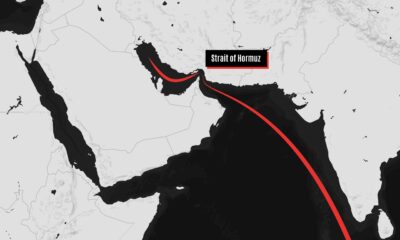Asia
Herat Security Dialogue discusses ways to overcome political uncertainty in Afghanistan
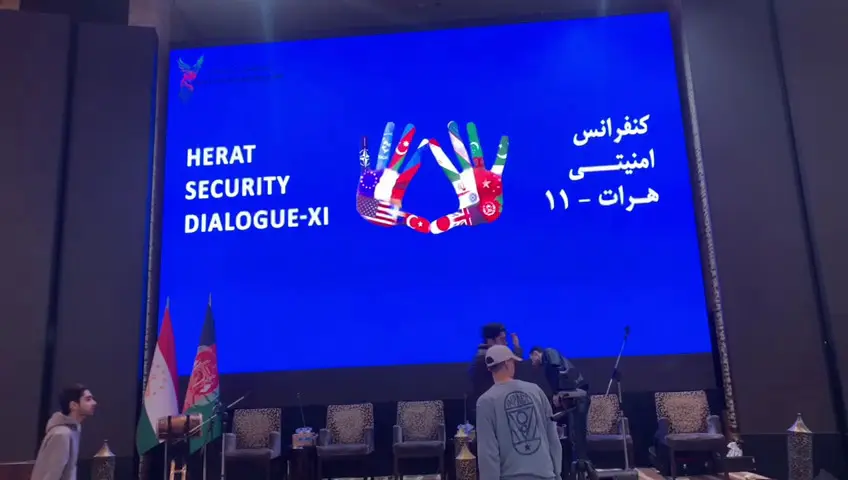
The 11th Herat Security Dialogue (HSD-XI) unfolded in Dushanbe, Tajikistan on 27-28 of November with the participation of over 120 people from 20 countries, including international organizations and representatives of various political groups and former republic government officials.
The HSD-XI held under the theme “Reimagining Afghanistan, Ways Forward”, concluded with the participants deliberating on various aspects, including the future of Afghanistan and the world’s community engagement with Afghanistan in their two-day session and several panel discussions.
The panelist discussed key issues related to Afghanistan, including gender apartheid, the rise of extremism and fundamentalism, and pushed for the support for political forces opposing the Taliban aimed at establishing an inclusive government acceptable for all.
The conference also shed light on various other important issues such as opening the way for a dialogue between politicians in exile and the Taliban, fight against terrorism, practical efforts to stop drug trafficking, good ties with the neighboring countries as well as having a society to honor the fundamental rights of girls and women.
The organizer of the conference, the Afghan Institute for Strategic Studies (AISS) had said that representatives from the United Nations, the European Union, and the Shanghai Cooperation Organization had also participated in the conference and merely played a role of observers.
Key officials from past government and foreign representatives participated in the HSD, discussing ways for a peaceful Afghanistan
During the first day of the conference, officials from the past government, opposition political figures, analysts and experts had discussed in detail the situation in Afghanistan and the focus was on the nature of interactions with the Taliban, who according to them, yet to agree for an intra-Afghan dialogue.
Head of AISS, Davood Moradian, said that this year’s discussions were solely focused on the future of Afghanistan with the Taliban as part of a solution or not. He said that what will happen if the Taliban doesn’t agree for a dialogue in order to form an inclusive government and if not, what steps should be taken in this regard.
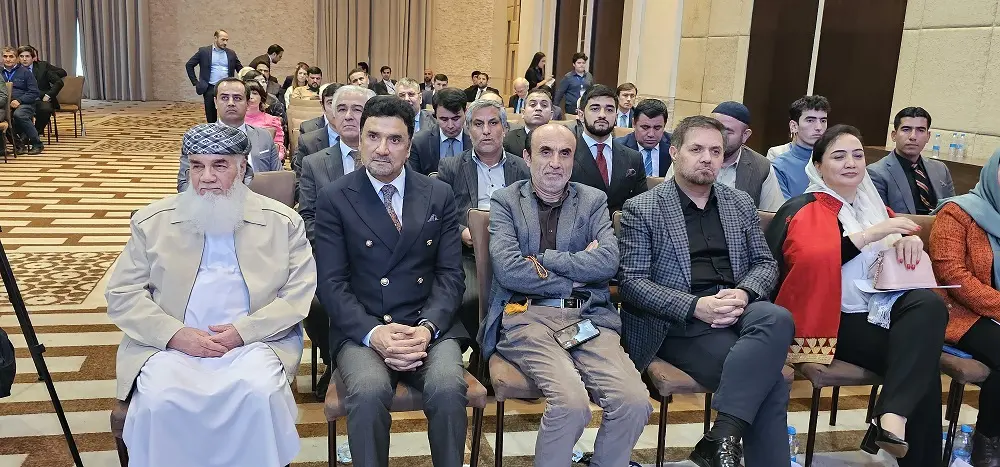
Former Afghan Minister, Ismail Khan and a number of officials, including Afghan ambassador to Tajikistan
In his opening speech, Dr. Rangin Dadfar Spanta, former Afghan foreign minister, said that Taliban took power in August 2021 due to the inefficiency of the republic government.
Spanta expressed his dissent on the report prepared by the UN Special Coordinator Feridun Sinirlioglu, saying that Feridun has tried to present a favorable image of the Taliban in the report.
Afghan leader, Ismail Khan called on international community to pressurize the Taliban in a bid to agree on intra-Afghan talks
“There was no need to whitewash the Taliban in the report,” Spanta added. Meanwhile, Shukria Barakzai, Afghanistan’s former envoy in Norway had questioned the UN’s dual stance, asking UN how it’s good for this organization to ask for a type of engagement or recognition of the Taliban when the Taliban doesn’t observe human rights, especially the rights of women and girls.
Chief guest, Ismail Khan, former Jihadi leader, had called on the international community to put pressure on the Taliban in order to make them agree on an opportunity for an intra-Afghan talk.
Expressing concern over world’s growing weary of the Taliban, Khan said that the current policy of Taliban will further strengthen the strongholds of resistance.
In August 2021, Khan announced war against the Taliban, but he was captured by the Taliban fighters and later on he was released and sought refuge in Iran. Now after two years, he appeared in the media once again and spoke against the Taliban. During his speech, he said that not only Iran, but the entire world has become fed up with the policy of the Taliban.
However, Karim Amin, a member of the leadership of the Hezb-e-Islami party led by Gulbuddin Hekmatyar, had somehow supported the report made by the Sinirlioglu. He said that Mr. Feridon Sinirlioglu has travelled to 15 provinces during his three months stay in Afghanistan and also met with the representatives of 17 provinces and also carried out talks with the three hundred people inside and outside of Afghanistan.
UK to envoy called on the world to reengage in Afghanistan
However, the former UK ambassador to Afghanistan, Nicholas Kay has put weight behind Sinirlioglu’s report and emphasized the need for the international community to support his’s UN-mandated assessment.
Afrasiab Khattak, a former Pakistani senator spoke about the mass deportation of Afghan migrants from Pakistan and said that this is the “policy of Pakistani generals” aimed at putting pressure on the people of Afghanistan. He said that these mass expulsions will end in instability in the region because when these people go to Afghanistan they won’t find any job and possibly be recruited by the Daes and TTP and other terrorist groups.
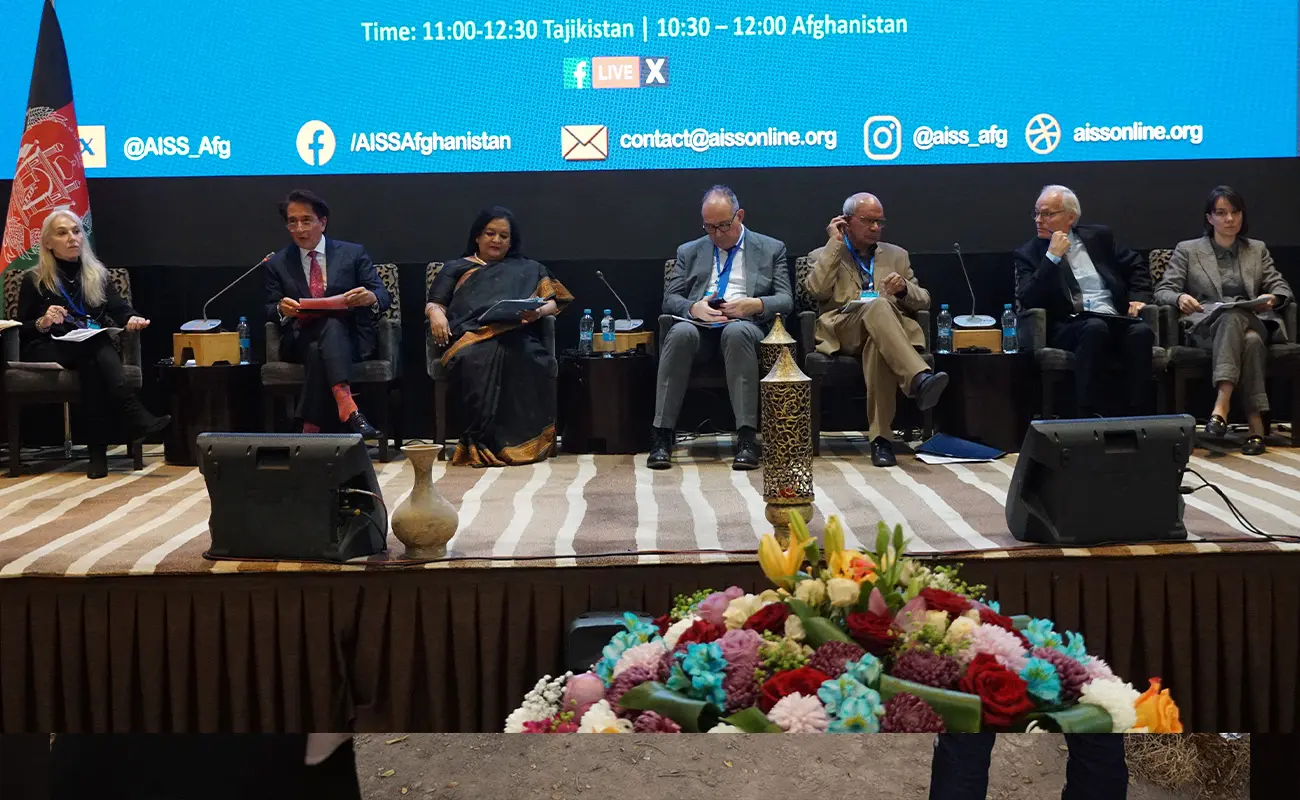
Panelist discussing Afghanistan issues.
Another participant, Abdullah Rahnama, A Tajik writer, has welcomed all the participants, especially the Afghans, labeling Tajikistan as their second home. Rahnama also expressed his grief over the recent earthquake in Herat province in which hundreds of people died, many more wounded and thousands of families became displaced.
Emphasized made upon a balanced international engagement for a peaceful a secure Afghanistan
In another discussion, Said Tayeb Jawad, former Afghan ambassador to Russia, has called for a pragmatic approach to Afghanistan’s issues, and called for a balanced international engagement and regional cooperation for a peaceful and secure future of Afghanistan.
In the same panel, Ashita Mittal, representative of the UN Office on Drugs and Crime in Uzbekistan, has called for a regional consensus on combating drug trafficking. She said that there is a need for further strengthening the borders due to increase in drug trafficking and illegal financial flows.
In another round of discussion, Shah Mahmood Miakhel, former Afghan defense minister, said that the Afghan politicians in exile have failed to design a unify strategy to combat extremism in the last two years.
At the end of the session, Davood Moradain, head of AISS, expressed gratitude for Tajikistan’s support for the people of Afghanistan. He said that after the collapse of the republic system, the world has left Afghanistan but the Tajikistan government didn’t leave Afghanistan and always stand ready to support the Afghan people.
Asia
Chinese navy chief and top nuclear scientist expelled from legislature

The chief of staff for the People’s Liberation Army (PLA) Navy, Vice Admiral Li Hanjun, and Liu Shipeng, the deputy chief engineer of the state-owned China National Nuclear Corporation, were removed from their positions in the country’s legislative body.
Li is the latest in a series of PLA generals and a handful of defense industry executives implicated in a widespread investigation within the military.
In a statement on Friday, the NPC Standing Committee announced, “The Navy Soldiers’ Congress has decided to remove Li Hanjun from his post as a representative to the 14th National People’s Congress.”
The Gansu People’s Congress also dismissed Liu Shipeng from his role as an NPC deputy.
Additionally, the Standing Committee revealed it had voted to remove Miao Hua, a former top general who previously oversaw the PLA’s ideological work, from the Central Military Commission (CMC), China’s highest military command body led by President Xi Jinping.
The removal of Li and Liu from their NPC memberships suggests they are facing serious disciplinary action.
China typically remains silent about purges within the military, and announcements from the NPC are one of the few indicators of such campaigns.
There is little public information available about Li and Liu, as both have worked in sensitive positions.
Before becoming the navy’s chief of staff, Li, 60, was the deputy director of the CMC’s Training and Administration Department. He was appointed to this role after serving for a year in the CMC’s Office for Reform and Organisational Structure.
In 2014, he was promoted to vice admiral upon his appointment as commander of the naval base in Fujian province, where Miao also spent a significant part of his career. At that time, he was the director of training at the China Naval Command College and was soon promoted to president of the school.
According to official media reports, nuclear scientist Liu was born into a family that “served China’s nuclear dream for three generations.”
As the deputy chief engineer at CNNC, which oversees all aspects of China’s civil and military nuclear programs, Liu also served as the Communist Party secretary and president of CNNC’s “404 base” in Gansu.
Covering an area of over 1,000 square kilometers, the base was established in 1958 and is the country’s first and largest nuclear research center. It played a crucial role in the development of China’s first atomic bomb in 1964 and its first hydrogen bomb three years later.
This secretive base is still considered a key hub for China’s nuclear deterrence and nuclear industry.
According to statements from provincial authorities, Liu was named “Gansu’s outstanding entrepreneur” in 2023.
Asia
China, US reach agreement on export controls

The Chinese Ministry of Commerce announced on Friday afternoon that Beijing and Washington have remained in close contact since the two-day trade talks in London earlier this month, confirming the details of a framework agreement.
“China will review and approve export applications for controlled items in accordance with its laws and regulations, and the US side will, in turn, lift a series of restrictive measures against China,” the ministry stated.
“We hope the US side will cooperate with China in line with the important consensus and conditions established during the conversation between the two presidents on June 5,” the statement continued.
On Thursday, US President Donald Trump said the US had “signed” a trade deal with China the previous day, without providing details.
“We signed the deal with China yesterday, right? We signed the deal with China,” Trump said at a White House event introducing a budget law. “With the China deal, we are starting to open up China,” he added.
He also mentioned that a “very big” deal, likely with India, would be signed soon.
Rare earth elements
Following the event, US Commerce Secretary Howard Lutnick told reporters that the US and China had signed an agreement codifying the terms decided upon in previous trade negotiations.
“They will deliver rare earth elements to us,” Lutnick said in a televised interview with Bloomberg, adding that if this commitment is fulfilled, Washington will lift its “countermeasures.”
Rare earth elements, essential for producing high-tech products, including those for the defense industry, were a major point of contention in the trade talks. China holds a near-monopoly on the supply of these minerals due to its massive share of global refining capacity.
Responding to a question on Thursday about rare earth exports, ministry spokesman He Yadong said China had approved a “certain number” of applications and would “continue to strengthen” the review and approval process for eligible applications.
He added that Beijing is willing to “strengthen communication and dialogue” with other countries on export controls and actively promote appropriate trade.
Lutnick also stated that the US plans to reach agreements with 10 major trading partners in the coming weeks. The deadline for countries to negotiate trade terms before higher tariffs are reinstated was July 9, following a 90-day suspension of import tariff hikes announced on April 2.
The two negotiating teams concluded the London talks by announcing they had agreed “in principle” on a “framework” that both sides would take home for their respective leaders to review, as they sought to get their uneasy truce, signed last month in Geneva, back on track.
The negotiations began after a highly anticipated phone call between Xi Jinping and Trump, which seemingly ended an intractable stalemate.
In the weeks following the initial agreement in Switzerland, Washington claimed China was restricting exports of critical minerals, while Beijing reacted to US restrictions on semiconductors and threats to impose visa barriers on Chinese students.
Asia
China hosts SCO defense ministers on warship amid regional tensions

Chinese Defense Minister Dong Jun hosted his Iranian counterpart and other high-level defense officials from Shanghai Cooperation Organisation (SCO) member states aboard an advanced Chinese warship, just days after the US bombed Iran’s nuclear facilities.
Iranian Defense Minister Aziz Nasirzadeh was among the defense officials welcomed by Dong on a military vessel in the coastal city of Qingdao, China, as part of a two-day SCO defense ministers’ meeting that concluded on Thursday.
According to Chinese state television CCTV, Nasirzadeh and other defense officials toured the People’s Liberation Army (PLA) Navy’s Type 052D destroyer, the Kaifeng, and later attended a reception on the ship’s deck.

Aboard the ship, Nasirzadeh thanked Beijing for “supporting Iran’s legitimate position following the recent attacks” by Israel and the US.
“We hope that China will continue to stand on the side of justice, help maintain the current ceasefire, and play a greater role in de-escalating regional tensions,” Nasirzadeh said, according to Xinhua.
In his address to the assembled ministers, Dong reportedly stated that “unilateralism, protectionism, and hegemonic and bullying acts are on the rise, seriously disrupting the international order and becoming the greatest source of chaos and conflict.”
Dong called for closer cooperation within the United Nations, the SCO, and other multilateral frameworks, urging members to unite with “more like-minded forces” to defend international justice and maintain global stability.
“SCO countries must remain true to the organization’s founding ideals, uphold the ‘Shanghai Spirit,’ and deepen practical cooperation in all areas,” Dong said. “With stronger actions, we can jointly safeguard a peaceful environment for development,” he added.
The event followed the US attacks on three of Iran’s key nuclear facilities on Saturday, which Beijing strongly condemned.
The Chinese Foreign Ministry stated that the attacks on nuclear facilities under the supervision of the International Atomic Energy Agency seriously violated the UN Charter and its principles.
Additionally, the SCO meeting coincided with a NATO leaders’ summit in The Hague. In a statement from The Hague, US President Donald Trump announced that the US would hold talks with Iran about a possible nuclear deal “in the coming week.”
Bilateral Talks
According to Xinhua, the Chinese defense minister later held separate bilateral meetings with the defense ministers of Belarus, Pakistan, Kyrgyzstan, and Russia. The state news agency reported that all parties appreciated Beijing’s efforts and significant contributions to developing SCO operational mechanisms and deepening inter-sectoral cooperation during its rotating presidency. They also expressed a strong will to further consolidate and expand military ties.
Pakistani Defense Minister Khawaja Asif praised Beijing’s role in de-escalating tensions. “Pakistan highly values its robust friendship with China and is ready to work together to implement its three global initiatives, deepen military cooperation, and help maintain regional peace and stability,” he said.
For Russian Defense Minister Andrei Belousov, this year—the 80th anniversary of the victory in World War II, the Chinese people’s war of resistance against Japanese aggression, and the world’s anti-fascist war—presents an opportunity to deepen bilateral military relations. “In line with the consensus of our leaders, we will intensify strategic communication and cooperation and contribute to global strategic stability,” he said.
Meanwhile, Indian Defense Minister Rajnath Singh also attended the Qingdao meeting. This marked the first visit by an Indian defense minister to China since the deadly border clash between the two countries in 2020.
Military trust
According to the Chinese Ministry of Defense, the SCO defense ministers’ meeting is one of the key events held during China’s rotating presidency of the SCO this year. The ministers, along with representatives from the SCO and regional anti-terrorism bodies, gathered to further strengthen military trust and deepen practical cooperation among member states.
The SCO, a 10-nation bloc comprising China, Russia, Kazakhstan, Kyrgyzstan, Tajikistan, Uzbekistan, Pakistan, India, Iran, and Belarus, currently covers approximately three-fifths of the Eurasian continent and about 43% of the world’s population.
The Beijing meeting, held under the rotating presidency of the Shanghai Cooperation Organisation, highlighted China’s role as a significant international actor and the importance Tehran places on its relationship with Beijing, even as China has largely remained on the sidelines of the Israel-Iran conflict.
During a regular press conference at the Chinese Ministry of Defense on Thursday, when asked if Beijing was considering providing military support to Iran as an SCO member, ministry spokesman Zhang Xiaogang told CNN, “China is ready to cooperate with all parties to play a constructive role in maintaining peace and stability in the Middle East.”
Kaifeng destroyer
The Kaifeng destroyer, where the meeting’s reception was held, is the sixth vessel of the extended Type 052D variant and serves in the North Sea Fleet. Commissioned in April 2021, the ship is approximately 159 meters (521 feet) long, weighs 7,500 tons, and is equipped with 517C anti-stealth radar. Its expanded deck allows for the landing of the PLA Navy’s Z-20 helicopters.
The warship has conducted numerous long-range exercises, including a passage through the Tsushima Strait in April, as part of Beijing’s growing operational presence in the western Pacific.
It was publicly displayed during the 74th-anniversary celebrations of the Chinese navy in Qingdao in 2023.
-

 Europe2 weeks ago
Europe2 weeks agoIsrael-Iran conflict postpones EU plan for Russian oil sanctions
-
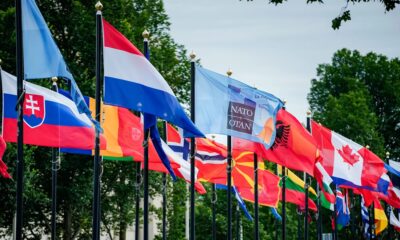
 Diplomacy2 weeks ago
Diplomacy2 weeks agoNATO summit focuses on arms race in the Silicon Valley age
-
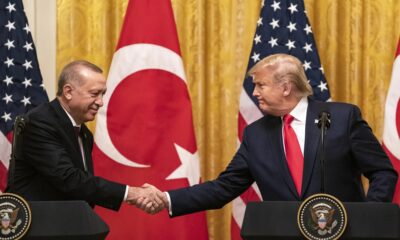
 Diplomacy2 weeks ago
Diplomacy2 weeks agoErdoğan to meet Trump at NATO summit to mend relations
-

 Diplomacy2 weeks ago
Diplomacy2 weeks agoIranian foreign minister travels to Moscow for Putin talks after US strikes
-

 Europe2 weeks ago
Europe2 weeks agoGermany to expand military with 11,000 new personnel this year
-

 Middle East2 weeks ago
Middle East2 weeks agoUS bombs Iranian nuclear sites, sparking fears of wider conflict
-
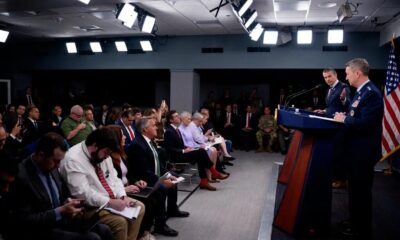
 America2 weeks ago
America2 weeks agoPentagon divided over military priorities in Asia and the Middle East
-

 Asia2 weeks ago
Asia2 weeks agoJapan’s prime minister skips NATO summit amid alliance strain




